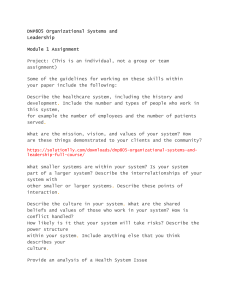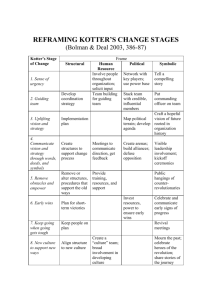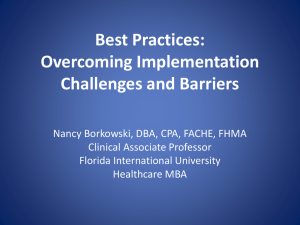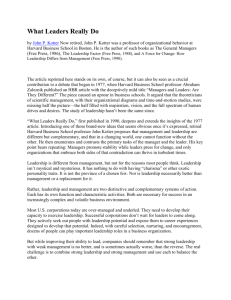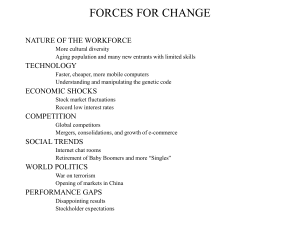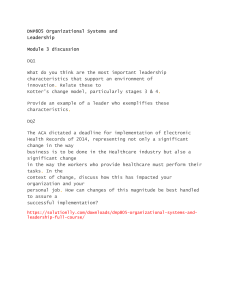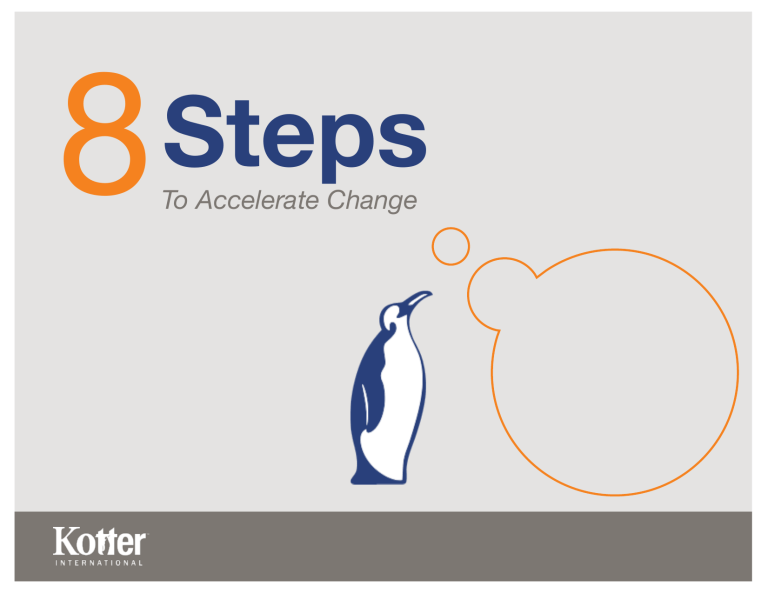
8 Steps To Accelerate Change 2017 will mark the 21st anniversary of John Kotter’s Leading Change, a book that’s been widely recognized as the seminal work in the field of change management. It introduced the 8-Step Process for Leading Change with a message to the reader: “You can lead change. Here is how to do it.” ©2017 Kotter International Six years ago, Dr. Kotter began observing organizations as they implemented the 8-Step Process with help from his firm. He saw proof that our world is moving a great deal faster than it was in the early 1990s. ©2017 Kotter International No matter how you look at it, the world is moving faster... ©2017 Kotter International Dr. Kotter also observed that the rate at which our world is changing is increasing, but our ability to keep up with it is not. ©2017 Kotter International What has remained the same? The two fundamental reasons behind most transformations are still the need... 1 To increase revenues/profits or decrease costs 2 To become more effective or more efficient Or both. ©2017 Kotter International Do your leaders and workforce present obstacles? Are they… • Disengaged from their roles, colleagues, managers, customers • Falsely urgent: consumed by constant activity and firefighting • Complacent: lulled into thinking that what got you here will get you there • Lopsided: focused more on management than on leadership • Siloed: known more for boundaries than gateways ©2017 Kotter International We at Kotter International have expanded our thinking and work – have enhanced our 8-Step Process – to give organizations additional capabilities to lead change under the particular conditions of today’s world. The breakthrough is in Accelerate, our book length study published by Harvard in 2014. We have increased the scope of the 8-Step Process from its original version to give it reach and potency in 2015 and beyond... ©2017 Kotter International Both versions are relevant and effective today, but they are designed to serve different contexts and objectives Leading Change’s 8-Step Process (1996) Accelerate’s 8-Step Process (2014) Respond to or affect episodic change in finite and sequential ways. Run the steps concurrently and continuously. Drive change with a small, powerful core group. Form a large volunteer army from up, down, and across the organization to be the change engine. Function within a traditional hierarchy. Function in a network flexibly and agilely outside of, but in conjunction with, a traditional hierarchy. Focus on doing one thing very well in a linear fashion over time. Constantly seek opportunities, identify initiatives to capitalize on them, and complete them quickly. ©2017 Kotter International The purpose of this eBook is to introduce you to the enhanced 8-Step Process ©2017 Kotter International STEP 1 Create a Sense of Urgency Your top leaders must describe an opportunity that will appeal to individuals’ heads and hearts and use this statement to raise a large, urgent army of volunteers. Companies with engaged employees have 5X higher shareholder returns 71% of the workforce is actively disengaged. Annually, this costs U.S. organizations 3 0 0 BILLION RESULTS You have a breadth of focused readiness across the workforce that is unprecedented in your organization. ©2017 Kotter International What is your Big Opportunity? • Do you see a Big Opportunity that could ignite the hearts and minds of your people? • Do you know how to identify, articulate and communicate it? • Are you able to connect an external change factor with a special capability of your organization? • What are the stakes if you succeed? Consequences if you fail? Windows of opportunity are appearing, opening, and closing more quickly than ever before. If you are able to identify even a glimmer of a Big Opportunity, it's important to quickly and urgently engage and mobilize around it before competitors seize the window. ©2017 Kotter International STEP 2 Build a Guiding Coalition A volunteer army needs a coalition of effective people — coming from its own ranks — to guide it, coordinate it and communicate its activities. Real collaboration is about stepping 81 % outside of traditional institutional structures to focus on results. In fact, there is an 81% correlation between collaboration and innovation. RESULTS The linchpin of your entire transformation is in place: an accountable, diverse group bound by opportunity, strategy and action. ©2017 Kotter International Is your organization capable of coordinating and sustaining change? • Can you get buy-in from 50% of the organization to drive large-scale change? • Do you have a way to engage a formalized network to take on innovative change initiatives? • Is work on strategic initiatives seen as "Have to" or "Want to"? • Do current hierarchical and silo-based structures stifle communication and engagement? Consider establishing a Guiding Coalition of engaged individuals from across your organization to help you institute the specific attitudes and practices necessary to launch, drive and — most importantly — sustain change. ©2017 Kotter International STEP 3 For a Strategic Vision and Initiatives Dr. Kotter defines strategic initiatives as targeted and coordinated "activities that, if designed and executed fast enough and well enough, will make your vision a reality." Business Week attributes 30% higher return on several key measures for companies with well-crafted mission statements describing why the business exists and its optimal desired future state. RESULTS You have a single vision of the future with a credibility and authority that comes from being crafted by a diverse set of employees and validated by senior leaders. ©2017 Kotter International Is your organization aligned under a Vision and how to act on it? • Where in your organization are people aligned around a single idea that inspires them to do things that move ideas forward? • Do people within the organization speak about the goals in the same way with the same priority? If not, how can these be aligned? • If you asked people around the organization about the Change Vision, how many different answers would you get? The better people can envision where they are going, the more they can focus on specific initiatives that will make that vision a reality. The strategic initiatives best positioned to capitalize on the Big Opportunity should be prioritized and staffed. With whom? That leads us to our next step... ©2017 Kotter International STEP 4 Enlist a Volunteer Army Large-scale change can only occur when very significant numbers of employees amass under a common opportunity and drive in the same direction. 147% Organizations with a high number of actively engaged employees have an average of 147% higher earnings per share than the norm. RESULTS You have a sizable body of employees excited and able to take action on critically important initiatives linked to your business strategy. ©2017 Kotter International Is it possible to create and tap a volunteer network at your organization? • What are examples of people in your organization who "step forward and act"? If there are few examples, what is stopping them? • Are employees invited and encouraged to help your organization implement its strategies? If yes, what are the successes? • How do you ensure that the successes are repeatable? How do you keep the volunteers engaged? Accelerate explains that "history has demonstrated that it is possible to find many change agents … but only if people are given a choice and feel they truly have permission to step forward and act." You must build excitement around the Big Opportunity and develop a feeling that one "Wants To" (not "Has To") contribute. ©2017 Kotter International STEP 5 Enable Action by Removing Barriers By removing barriers such as inefficient processes or hierarchies, leaders provide the freedom necessary for employees to work across boundaries and create real impact. 44% “Innovation is less about generating brand-new ideas and more about knocking down barriers to making those ideas a reality.” ~John Kotter, Accelerate of leaders agree that their own management strategies are too bureaucratic and are a nuisance ©2017 Kotter International RESULTS You have tangible evidence of employee innovations stemming from collapsed silos and new ways of working together. Do you know where your organization’s barriers are? • Have past change initiatives in your organization failed? If so, what barriers stopped them from succeeding? • Which of the most common barriers do you have — silo parochialism, pressure to make quarterly numbers, complacency, rules and procedures, or a limited number of change leaders? • Barriers can be commonly stated and accepted statements that, while appearing helpful, can deter attempts to get past legacy obstacles. These are statements like, "It's just not done that way," or, "We tried that before — it didn't work." Over time, the hierarchies that serve organizations so well in terms of efficiency and order can limit transformation. The cross-functional Guiding Coalition can work in tandem with hierarchical management to help change leaders over come barriers. ©2017 Kotter International STEP 6 Generate Short-Term Wins Wins are the molecules of results. They must be collected, categorized, and communicated — early and often — to track progress and energize your volunteers to drive change. It takes about six years of hard work to become an overnight success. ~Seth Godin RESULTS A body of wins data that tells the story of your transformation is validated, quantifiable and qualifiable terms. ©2017 Kotter International Do you generate and celebrate wins? • What are some examples of initiatives in your organization that were successful and part of a sustained effort? Why did they work? • How often do you hear about successes in your organization? If rarely, is it because there aren't any, or because they aren't shared and celebrated? • Does your organization have what it takes to collect, correlate and celebrate wins? A change vision can take a long time to achieve. Dr. Kotter's research has shown that generating and celebrating wins along the way is vital to acceleration towards and focus on the goal. ©2017 Kotter International STEP 7 Sustain Acceleration Change leaders must adapt quickly in order to maintain their speed. Whether it's a new way of finding talent or removing misaligned processes, they must determine what can be done — every day — to stay the course towards the vision. Agile firms see a % 37 increase in revenue when they employ leaders who strategically adapt to any situation. RESULTS You have confirmation of organizational fitness and stamina that enable the reinvigoration of your mission and help you and your employees stay the course of change over time. ©2017 Kotter International Are you balancing change management with change leadership? Management • • • • • • • • Planning Budgeting Organizing Staffing Problem Solving Measuring Doing What We Know How To Do Producing Dependable, Reliable Results Leadership • • • • • • Establishing Direction Aligning People Motivating Inspiring Mobilizing People to Achieve Astonishing Results Propelling Us Into The Future Balance is the essential factor in sustaining acceleration. How do you counterweight the tendency to over-manage? Where are the opportunities for people up and down your organization to behave more like leaders? ©2017 Kotter International STEP 8 Institute Change To ensure new behaviors are repeated over the long-term, it's important that you define and communicate the connections between these behaviors and the organization's success. When surveyed, 90% of managers and employees said the importance of agility and speed has increased in the last 5 years. RESULTS You have collective recognition that your organization has a new way of working with speed, agility and innovation that directly contributes to strategically important business results. ©2017 Kotter International How can you institute the change? Volunteer Army The Big Opportunity Results How do you use the persistent celebration of Big Opportunity wins to maintain the engagement of the volunteer army and embed these new ways of working in the organization? ©2017 Kotter International How can you balance reliability and agility? There must be clear communication and synchronization between the traditional hierarchical structure (on the left side) and the innovation network of volunteers (on the right side). How will you achieve this? ©2017 Kotter International The need to transform is critical If you know you need to transform but aren't sure where to start, call us: We will teach you how to execute the 8 Steps yourselves. Us ©2017 Kotter International You We help clients transform into fast, agile organizations CONTACT US Phone: (855) 400.4712 Email: Info@Kotterinternational.com Website: Kotterinternational.com Twitter: @KotterIntl We are the world’s only firm capable of combining our empirical research and proprietary process to help your organization truly transform itself. Learn to lead your large-scale transformation by working with our Advisory Services. Build your change leadership skills through our Center for Leaders. Or work with both to create sustainable change capacity and capability across all levels of your organization. Regardless of the approach, tangible business impact is the result.

